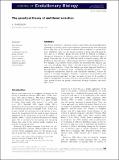Files in this item
The genetical theory of multilevel selection
Item metadata
| dc.contributor.author | Gardner, Andy | |
| dc.date.accessioned | 2015-01-08T15:31:05Z | |
| dc.date.available | 2015-01-08T15:31:05Z | |
| dc.date.issued | 2015-03-11 | |
| dc.identifier | 159358410 | |
| dc.identifier | 8e165b68-f70d-4a56-913f-d106d1134433 | |
| dc.identifier | 84925649983 | |
| dc.identifier | 000351208800003 | |
| dc.identifier | 25475922 | |
| dc.identifier.citation | Gardner , A 2015 , ' The genetical theory of multilevel selection ' , Journal of Evolutionary Biology , vol. 28 , no. 2 , pp. 305-319 . https://doi.org/10.1111/jeb.12566 | en |
| dc.identifier.issn | 1010-061X | |
| dc.identifier.other | Bibtex: urn:5b1a5faa3767cd7dfa9d6b5cbafc23f2 | |
| dc.identifier.uri | https://hdl.handle.net/10023/5979 | |
| dc.description | This work was supported by the Natural Environment Research Council (grant number NE/K009524/1). | en |
| dc.description.abstract | The theory of multilevel selection (MLS) is beset with conceptual difficulties. Although it is widely agreed that covariance between group trait and group fitness may arise in the natural world and drive a response to ‘group selection’, ambiguity exists over the precise meaning of group trait and group fitness and as to whether group selection should be defined according to changes in frequencies of different types of individual or different types of group. Moreover, the theory of MLS has failed to properly engage with the problem of class structure, which greatly limits its empirical application to, for example, social insects whose colonies are structured into separate age, sex, caste and ploidy classes. Here, I develop a genetical theory of MLS, to address these problems. I show that taking a genetical approach facilitates a decomposition of group‐level traits – including reproductive success – into the separate contributions made by each constituent individual, even in the context of so‐called emergence. However, I uncover a novel problem with the group‐oriented approach: in many scenarios, it may not be possible to express a meaningful covariance between trait and fitness at the level of the social group, because the group's constituents belong to separate, irreconcilable classes. | |
| dc.format.extent | 15 | |
| dc.format.extent | 452404 | |
| dc.language.iso | eng | |
| dc.relation.ispartof | Journal of Evolutionary Biology | en |
| dc.subject | Class structure | en |
| dc.subject | Covariance | en |
| dc.subject | Emergence | en |
| dc.subject | Evolutionary genetics | en |
| dc.subject | Group selection | en |
| dc.subject | Natural selection | en |
| dc.subject | Price's theorem | en |
| dc.subject | Social evolution | en |
| dc.subject | Simpson's paradox | en |
| dc.subject | Reproductive value | en |
| dc.subject | QH301 Biology | en |
| dc.subject | T-NDAS | en |
| dc.subject | BDC | en |
| dc.subject | R2C | en |
| dc.subject.lcc | QH301 | en |
| dc.title | The genetical theory of multilevel selection | en |
| dc.type | Journal article | en |
| dc.contributor.sponsor | NERC | en |
| dc.contributor.institution | University of St Andrews. School of Biology | en |
| dc.contributor.institution | University of St Andrews. Centre for Biological Diversity | en |
| dc.identifier.doi | 10.1111/jeb.12566 | |
| dc.description.status | Peer reviewed | en |
| dc.identifier.grantnumber | NE/K009524/1 | en |
This item appears in the following Collection(s)
Items in the St Andrews Research Repository are protected by copyright, with all rights reserved, unless otherwise indicated.

